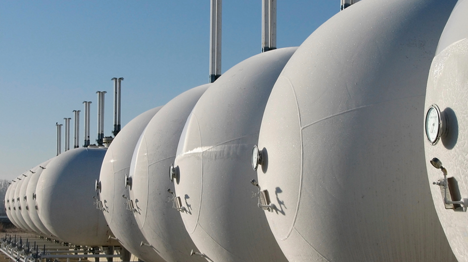Liquefied gas

Liquefied gas (also referred to as LPG, Liquefied Petroleum Gas) generally refers to mixtures with a high content of the hydrocarbons propane and butane. These accumulate primarily in the distillation of crude oil. The ratio of the two gases in terms of total content differs widely. All mixtures can be liquefied under slight pressure, which makes it possible to compress the volume by a ratio of 1:260. The gas can be stored in tanks in this liquid state and transported by ship, rail or truck. In contrast to natural gas, propane pipelines are rather rare. Like natural gas, liquefied gas offers the advantages of very clean combustion and low emission values. On the other hand, the price per kWh is almost always higher than for natural gas and the operator must maintain various plants to store and gasify the mixture which is delivered in a liquid state for liquefied gas firing.
Propane/butane mixtures may have different compositions depending on the climate zone so that the liquid gas mixture can evaporate easily even at low temperatures. Depending on the mixing ratio, the heat value of liquefied gas is between 93 and 124 MJ/m³. Due to the differing composition, the ignition limit also fluctuates between 2.2 and 9.5% by vol. in air.
In any case the uncompressed gaseous mixture is heavier than air. Depending on the composition, the relative density is between 1.6 and 2.1. Like natural gas, odorous substances are also added to liquefied gas so that leaks can be detected quickly. Depending on the mixing ratio, between 24 and 32 m³ of air is required for the stoichiometric combustion of one cubic meter of gas (equivalent to 2 - 2.7 kg). The ignition limit is between 1.5 and 9.5% by vol. in air. If firing is optimally adjusted, liquefied gas combusts almost completely to form carbon dioxide and water. In dry combustion air the dew point of wet flue gas is about 54°C.